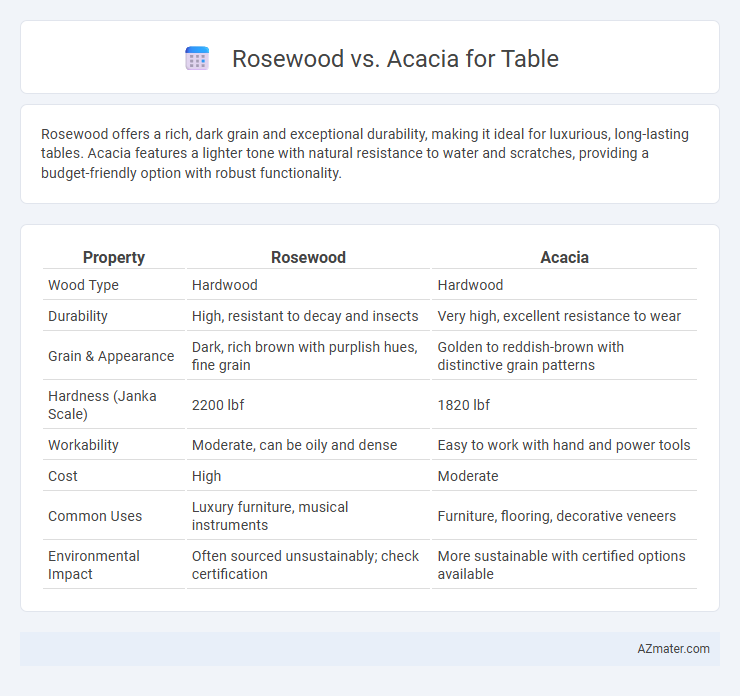Rosewood offers a rich, dark grain and exceptional durability, making it ideal for luxurious, long-lasting tables. Acacia features a lighter tone with natural resistance to water and scratches, providing a budget-friendly option with robust functionality.
Table of Comparison
| Property | Rosewood | Acacia |
|---|---|---|
| Wood Type | Hardwood | Hardwood |
| Durability | High, resistant to decay and insects | Very high, excellent resistance to wear |
| Grain & Appearance | Dark, rich brown with purplish hues, fine grain | Golden to reddish-brown with distinctive grain patterns |
| Hardness (Janka Scale) | 2200 lbf | 1820 lbf |
| Workability | Moderate, can be oily and dense | Easy to work with hand and power tools |
| Cost | High | Moderate |
| Common Uses | Luxury furniture, musical instruments | Furniture, flooring, decorative veneers |
| Environmental Impact | Often sourced unsustainably; check certification | More sustainable with certified options available |
Introduction: Comparing Rosewood and Acacia for Tables
Rosewood and Acacia are popular hardwood choices for tables due to their durability and rich grain patterns. Rosewood is prized for its deep, reddish-brown hue and natural oils that enhance resistance to wear and moisture. Acacia offers a lighter, varied color palette with exceptional hardness, making it ideal for sturdy, long-lasting furniture.
Wood Characteristics: Rosewood vs Acacia
Rosewood is known for its rich, dark reddish-brown hue with prominent grain patterns, offering high density and durability, making it ideal for premium tables. Acacia features a lighter, golden to medium brown color with natural variations and a smoother texture, prized for its resilience and water resistance. Rosewood's tight grain and oily finish enhance scratch resistance, while Acacia's hardness and flexibility provide excellent structural integrity for everyday use.
Appearance and Grain Patterns
Rosewood tables exhibit rich, dark hues with deep reddish or purplish undertones and intricate grain patterns that often display swirling, tiger stripes, or bird's eye figures, making each piece unique and luxurious. Acacia tables feature a lighter, golden to medium brown color with a more uniform and straight or irregular grain that can include knots and natural variations, lending a warm and rustic charm. The contrasting visual appeal of rosewood's dramatic, dense grain versus acacia's more varied and natural texture allows buyers to choose between opulence and organic character for their furniture.
Durability and Longevity
Rosewood offers exceptional durability with natural resistance to wear, scratches, and moisture, making it ideal for long-lasting tables in high-traffic areas. Acacia, known for its hardness and dense grain, provides strong resistance to dents and scratches, though it may require regular maintenance to preserve its longevity. Both woods ensure durable furniture, but Rosewood generally outperforms Acacia in long-term durability and resistance to environmental factors.
Hardness and Strength
Rosewood exhibits a Janka hardness rating of approximately 2200 to 2350, making it exceptionally dense and resistant to dents, ideal for durable table surfaces. Acacia, with a Janka hardness ranging from 1700 to 1900, provides substantial strength but is slightly less hard than Rosewood, offering good resistance to wear and impact. The superior hardness and tensile strength of Rosewood translate to greater longevity and better performance in high-traffic table applications compared to Acacia.
Maintenance and Care
Rosewood tables require regular oiling with rosewood-specific oils to maintain their natural luster and prevent drying, while avoiding harsh chemicals that can damage the wood's surface. Acacia tables demand frequent cleaning with mild soap and water to prevent dirt buildup, along with occasional reapplication of protective finish to resist moisture and stains. Both woods benefit from avoiding direct sunlight and using coasters to extend durability and preserve their rich appearance.
Cost and Value Comparison
Rosewood tables are typically more expensive than acacia due to their dense grain, rich color, and durability, making them a premium choice for luxury furniture. Acacia offers a more budget-friendly option with good durability and a distinctive grain pattern, providing excellent value for cost-conscious buyers. While rosewood commands higher prices, acacia tables balance cost and aesthetic appeal, making both choices viable depending on budget and desired quality.
Sustainability and Environmental Impact
Rosewood harvesting often involves illegal logging and habitat destruction, raising significant sustainability concerns due to its slow growth and endangered status in many regions. Acacia, known for its fast growth and ability to thrive in poor soils, presents a more sustainable option with lower environmental impact and better carbon sequestration capabilities. Choosing Acacia for tables supports forest conservation efforts and reduces the risk of contributing to deforestation compared to Rosewood.
Best Uses for Each Wood in Tablemaking
Rosewood's dense grain and rich dark hues make it ideal for luxury dining tables, accentuating fine craftsmanship and offering durability against wear. Acacia's natural resistance to moisture and striking grain patterns suit outdoor or rustic-style tables, providing longevity and a warm, inviting aesthetic. Both woods excel in tabletops but differ in optimal applications due to Rosewood's polish-ready surface and Acacia's robustness in varied environments.
Final Verdict: Which Wood is Better for Your Table?
Rosewood offers exceptional durability and rich, dark hues that make it ideal for luxurious, long-lasting tables, while Acacia provides a more affordable option with impressive hardness and a warm, varied grain pattern. Consider Rosewood if you prioritize elegance and longevity, but choose Acacia for cost-effectiveness and unique natural beauty. Ultimately, the best choice depends on your budget, style preferences, and the desired durability of your table.

Infographic: Rosewood vs Acacia for Table
 azmater.com
azmater.com